Continued decline in share of U.S. adults with up-to-date vaccination

Pew Research Center conducted this study to understand Americans’ views of the coronavirus and COVID-19 vaccines. For this analysis, we surveyed 10,133 U.S. adults from Feb. 7 to 11, 2024.
Everyone who took part in the survey is a member of the Center’s American Trends Panel (ATP), an online survey panel that is recruited through national, random sampling of residential addresses. This way, nearly all U.S. adults have a chance of selection. The survey is weighted to be representative of the U.S. adult population by gender, race, ethnicity, partisan affiliation, education and other categories. Read more about the ATP’s methodology.
Here are the questions used for this report, along with responses, and its methodology.
A new Pew Research Center survey finds that just 20% of Americans view the coronavirus as a major threat to the health of the U.S. population today and only 10% are very concerned they will get it and require hospitalization. This data represents a low ebb of public concern about the virus that reached its height in the summer and fall of 2020, when as many as two-thirds of Americans viewed COVID-19 as a major threat to public health.
Just 28% of U.S. adults say they have received the updated COVID-19 vaccine, which the Centers for Disease Control and Prevention (CDC) recommended last fall to protect against serious illness. This stands in stark contrast to the spring and summer of 2021, when long lines and limited availability characterized the initial rollout of the first COVID-19 vaccines. A majority of U.S. adults (69%) had been fully vaccinated by August 2021.
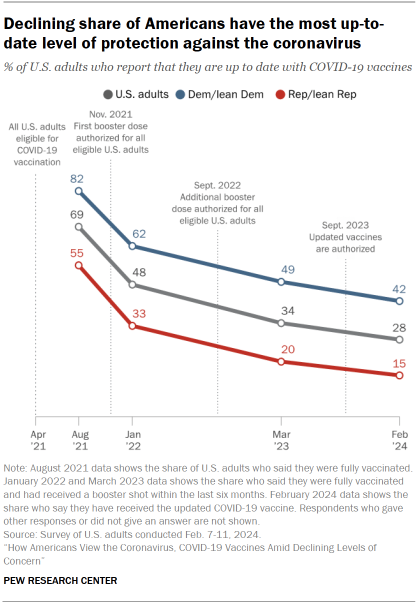
Underscoring the limited demand for the updated COVID-19 vaccines, a larger share of U.S. adults say they’ve gotten a flu shot in the last six months than the updated coronavirus vaccine (44% vs. 28%). And despite a public health push encouraging adults to get both vaccines at the same time, almost half of those who received a flu shot from a health care provider chose not to get the updated COVID-19 vaccine.
The vast majority of Americans have some level of protection from the coronavirus because of vaccination, prior infection or a combination of the two. This has led to a decline in severe illness from the disease.
Still, the virus continues to circulate widely in the United States, with wastewater data suggesting that cases in the early part of 2024 were among the highest they have been since the first omicron wave in 2022.
Long COVID ranks among the concerns of public health experts. Long COVID refers to a variety of symptoms such as fatigue and brain fog that last longer than a month after a COVID-19 infection.
The survey – conducted among 10,133 U.S. adults from Feb. 7 to 11, 2024 – finds that 50% of Americans say it is extremely or very important for medical researchers and health care providers to understand and treat long COVID; 27% see this as a less important issue and 22% of Americans say they haven’t heard of long COVID.
Continuity and change: Partisan views of COVID-19
Partisanship remains one of the most powerful factors shaping views about COVID-19 vaccines and the virus. But the size and nature of differences between Republicans and Democrats have evolved since earlier stages of the outbreak.
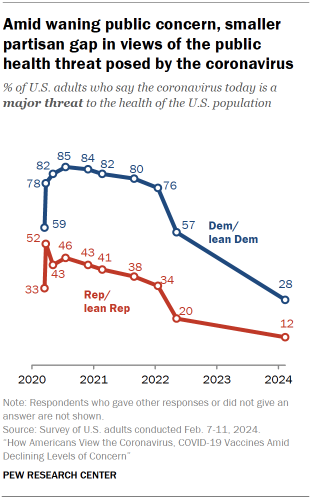
For instance, the gap between the shares of Democrats and Republicans who view the coronavirus as a major threat to public health has fallen from 37 percentage points in May 2022 to 16 points today. In the pandemic’s first year, Democrats were routinely about 40 points more likely than Republicans to view the coronavirus as a major threat to the health of the U.S. population. This gap has waned as overall levels of concern have fallen.
When it comes to vaccination, Democrats and Democratic-leaning independents remain more likely than Republicans and GOP leaners to say they’ve received an updated COVID-19 vaccine (42% vs. 15%). This 27-point gap in recent vaccination is about the same as in January 2022 when 62% of Democrats and 33% of Republicans said they were up to date (i.e., fully vaccinated and recently boosted).
In addition to partisanship, age continues to matter a great deal in attitudes and behaviors tied to the coronavirus. And the intersection of partisanship and age reveals one of the biggest recent changes in the public’s response to the outbreak: a growing divergence between the oldest Republicans and oldest Democrats in vaccine uptake, which is explored below.
COVID-19 vaccination among adults ages 65 and older, by party
Older adults continue to be one of the most at-risk groups for severe illness and death from COVID-19.
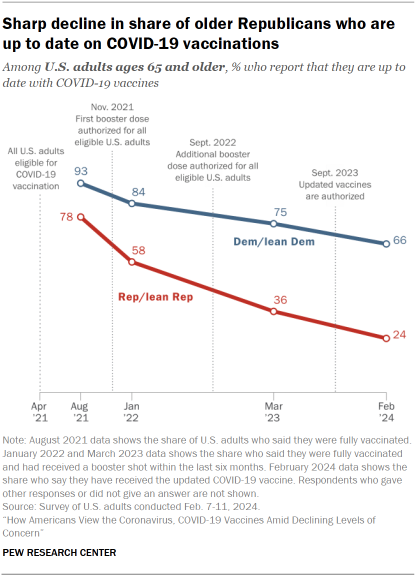
When vaccines first became available in 2021, large majorities of both Republicans and Democrats ages 65 and older said they had received the vaccine. But as additional doses have become available, uptake among older Republicans has declined at a faster rate than among older Democrats.
In the current survey, 66% of Democrats ages 65 and older say they have received the updated COVID-19 vaccine, compared with 24% of Republicans ages 65 and older.
This 42-point partisan gap is much wider now than at other points since the start of the outbreak. For instance, in August 2021, 93% of older Democrats and 78% of older Republicans said they had received all the shots needed to be fully vaccinated (a 15-point gap). Go to the Appendix for more details.
How COVID-19 vaccination varies by age within parties

The impact of age is also striking when looking within political parties.
Among Democrats, about three-in-ten adults under 50 have received an updated COVID-19 vaccine, compared with 48% of those ages 50 to 64 and 66% of Democrats ages 65 and older.
Age differences within the GOP run in the same direction, but are much more modest, reflecting, in part, low overall levels of vaccine uptake.
How COVID-19 vaccination varies by race and ethnicity
Similar shares of White (28%), Black (29%) and Hispanic (27%) adults say they have gotten the updated vaccine. English-speaking Asian adults (35%) are slightly more likely to report receiving the updated vaccine.
As in past Center surveys, there are racial and ethnic differences in vaccine uptake among Democrats.
For instance, 50% of White Democrats and 42% of English-speaking Asian Democrats report having received the updated vaccine, compared with somewhat smaller shares of Black and Hispanic Democrats (32% each).
Views of long COVID
Half of Americans say it is extremely or very important for medical researchers and health care providers to understand and treat long COVID, considering all the different priorities they face.
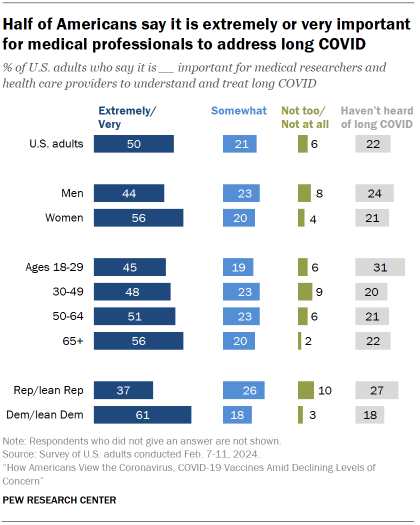
About two-in-ten (21%) say it’s somewhat important for those in medicine to address long COVID, while 6% say it is not too or not at all important. Another 22% say they haven’t heard of long COVID.
More Democrats (61%) than Republicans (37%) say it is extremely or very important for medical researchers and health care providers to understand and treat long COVID.
A majority of women (56%) consider this extremely or very important; a smaller share of men (44%) say the same. The CDC has reported that women are more likely than men to develop long COVID symptoms.
Awareness of long COVID also shapes views on its importance: Those who have heard a lot about long COVID are more likely than those who have heard a little about it to say it’s extremely or very important for medical professional to address it (76% vs. 60%).
Views of the threat posed by the coronavirus
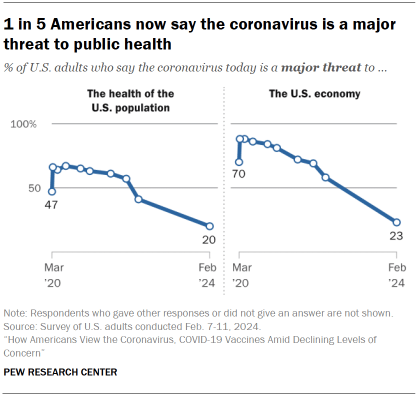
One-in-five Americans now say the coronavirus is a major threat to the health of the U.S. population, down from a high of 67% in July 2020.
Concern about the coronavirus as a major threat to the U.S. economy has also declined dramatically. Today, 23% of Americans say it’s a major threat to the economy, compared with 88% in May 2020. The pandemic spurred an economic recession in 2020 and a spike in unemployment that reached the highest levels since the Great Recession.
Federal policy on the coronavirus has changed as public concern – and the incidence of severe illness – has fallen. The Biden administration ended the public health emergency for the coronavirus pandemic in May 2023. And the CDC recently released updated guidelines with shorter isolation periods for adults testing positive for the disease.
While large partisan gaps characterized views of the coronavirus as a major threat to public health for much of the pandemic, those gaps were far smaller on views of the virus as a major threat to the economy. In the current survey, just a 6-point gap separates Republicans and Democrats with this view (20% vs. 26%, respectively) – similar to the 9-point party gap seen in May 2022.
Personal concern about getting or spreading COVID-19
About a quarter of Americans (27%) are very or somewhat concerned about getting a serious case of COVID-19 that would require hospitalization. A somewhat higher share (40%) say they are very or somewhat concerned they might spread the coronavirus to other people without knowing it.

Levels of concern for getting or spreading the coronavirus are about the same as they were in March 2023 and remain down dramatically from early in the pandemic.
The share of Americans who are very or somewhat concerned about getting a serious case is 26 points lower than in November 2020, before a COVID-19 vaccine was available to the public. And the share of Americans who are at least somewhat concerned about spreading COVID-19 without knowing it is down 24 points since November 2020.
Still, the current data shows how the virus remains a concern in daily life for many Americans, more than four years after the first confirmed coronavirus cases appeared in the U.S.
Consistent with past Center surveys, there are demographic and political differences in personal concern about getting a serious case of COVID-19 and unknowingly spreading the virus:
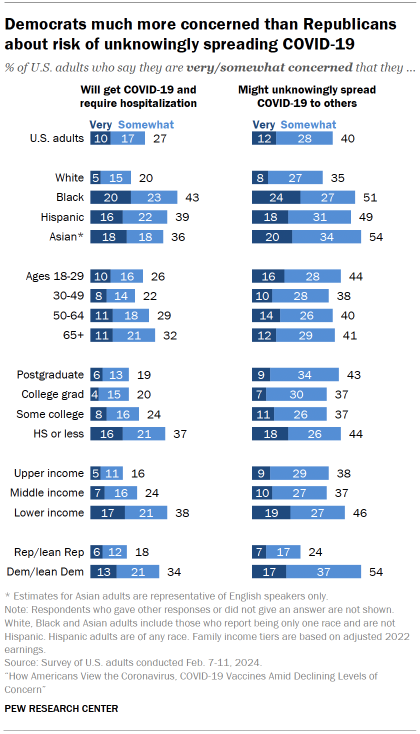
- Income: Lower-income Americans continue to be particularly concerned (38%) about getting a serious case of COVID-19. They’re also more likely than middle- and upper-income Americans to worry about unknowingly spreading COVID-19, but the differences are more modest.
- Party: Democrats (54%) are more than twice as likely as Republicans (24%) to be very or somewhat concerned about unknowingly spreading COVID-19. And they’re 16 points more likely to express concern about getting a serious case of the disease.
- Race and ethnicity: White Americans (20%) are less likely to be concerned about getting a serious case of COVID-19 than Black (43%), Hispanic (39%) and English-speaking Asian Americans (36%).
Some of the groups most personally concerned about getting a severe case of COVID-19 are also among the groups most concerned about the public health threat from the coronavirus. For example, Black adults and adults with lower incomes express more concern about the personal health and public health impact of the coronavirus than White adults and those with upper incomes.
Uptake of the flu shot
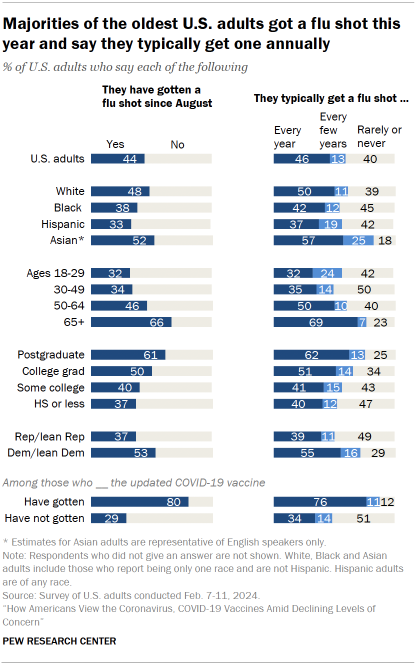
The survey finds 44% of U.S. adults say they have gotten a flu shot since August. This share is down slightly from last March, when 49% of Americans said they had recently gotten a flu shot.
Uptake varies by the following factors:
- Age: Older Americans continue to be more likely to report getting the flu shot. Two-thirds of Americans ages 65 and older say they have gotten the flu shot since August. By comparison, only about a third of those under age 50 say the same. These large age differences are seen among both Democrats and Republicans.
- Race and ethnicity: English-speaking Asian Americans (52%) and White Americans (48%) are more likely than Black Americans (38%) and Hispanic Americans (33%) to say they have gotten a flu shot since August. These racial and ethnic differences are consistent with past Center surveys.
- Partisan affiliation: Democrats are more likely than Republicans to say they got a flu shot this year (53% vs. 37%). This 16-point gap is twice as big now as it was in November 2020, during the pandemic’s first year. The current partisan difference in flu shot uptake is similar to the one recorded in March 2023.
The flu shot and updated COVID-19 vaccines are both recommended to protect against severe illness, but Americans approach these vaccines differently.

Americans are more likely to report that they received a flu shot than the updated COVID-19 vaccine this year (44% vs. 28%).
This gap in uptake between the flu shot and updated COVID-19 vaccine is more pronounced among Republicans than Democrats.
Republicans are more than twice as likely to say they’ve gotten a flu shot since August as to say they’ve received an updated COVID-19 vaccine (37% vs. 15%). Among Democrats, this difference is more modest (53% vs. 42%).


